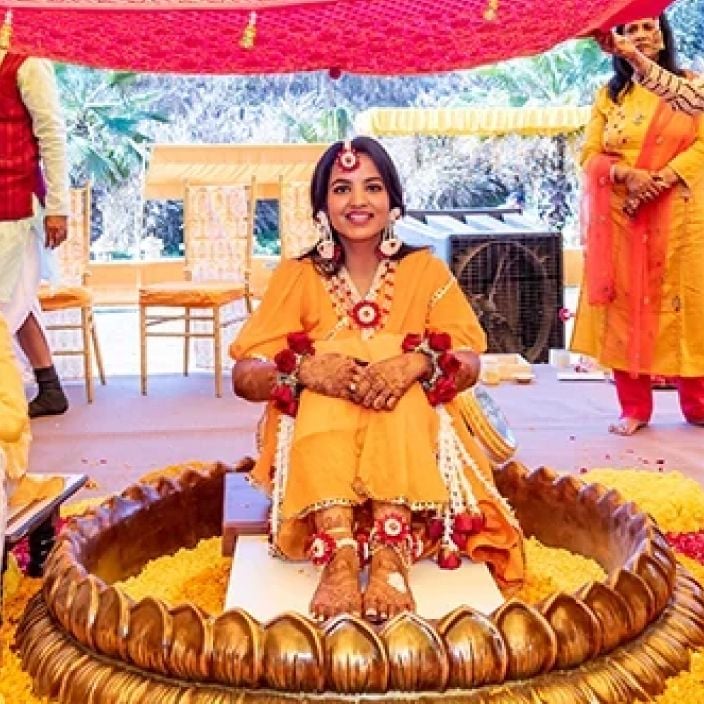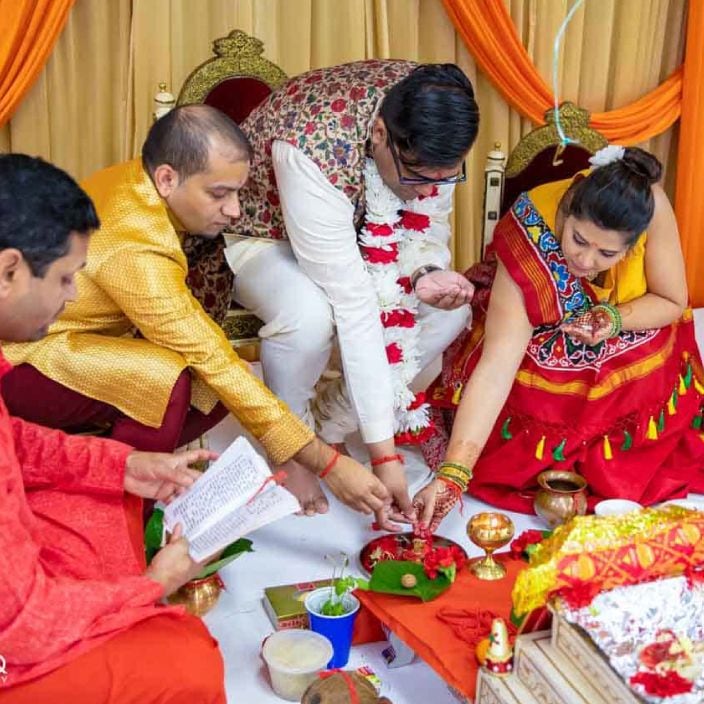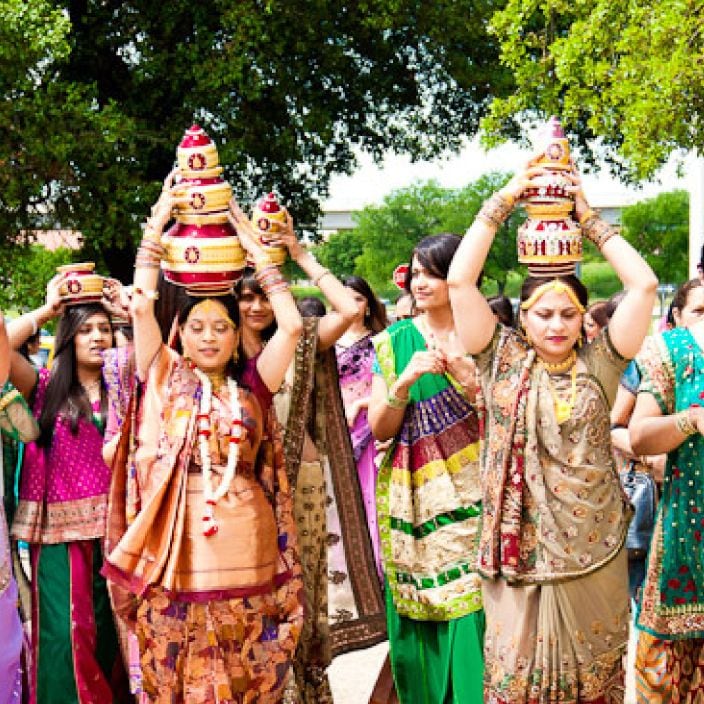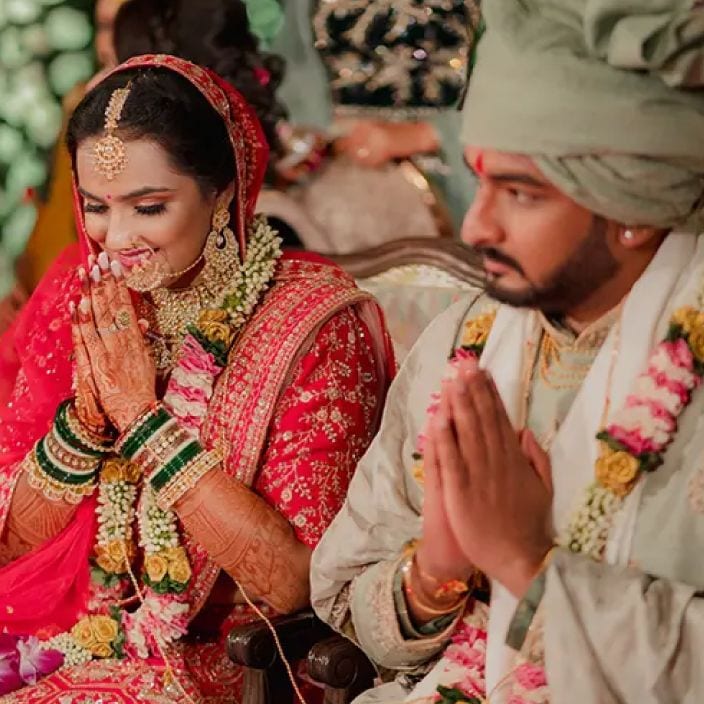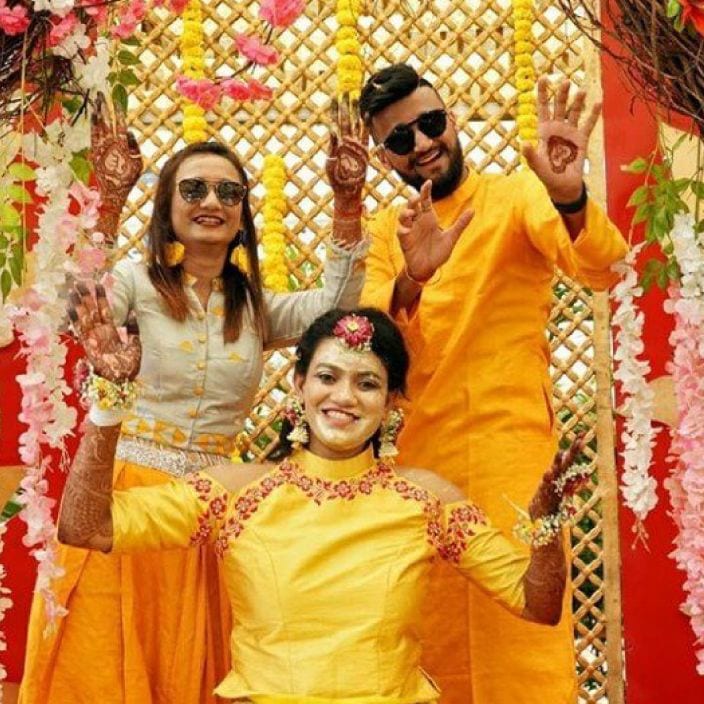For best prices and early deliveries, WhatsApp us at. 918488070070
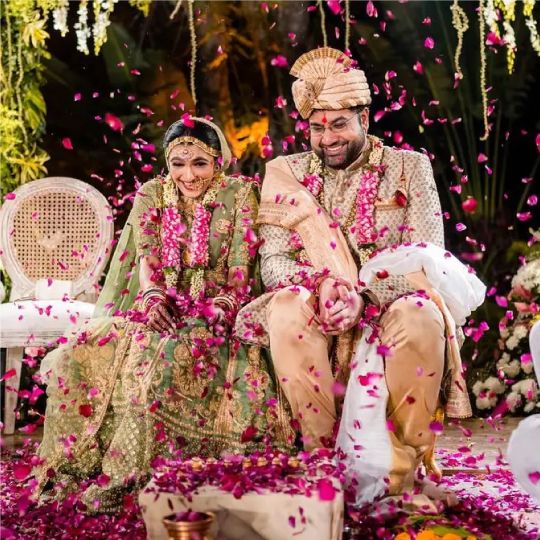
Gujarat
Gujarati weddings are known for being spirited celebrations that honour love, tradition, and culture. The western state is famous for its colourful customs and festivals – an energy that flows into its wedding ceremonies as well. The state has a majority Hindu population but also includes communities like Jains, Patels, and Lohanas, each contributing their own unique customs to the wedding festivities. A Gujarati wedding is a blend of rituals, music, dance, and delicious cuisine that creates lasting memories for all involved.
Tracing the Traditions
The pre-wedding rituals kick off with Chandlo Vidhi, where the groom and his male family members visit the bride's home. During this ceremony, the bride's father applies a vermillion Tika, called Chandlo, on the groom's forehead as a blessing and gives him token money. This ritual also marks the wedding date's setting for both families.
God Dhana is the Gujarati engagement ceremony. The bride's family brings sweets and gifts to the groom's house. The couple exchanges engagement rings and seeks blessings from five married women from each side of their families. This joyful event is followed by a delicious feast celebrating the local cuisine.
The initiation of the wedding festivities starts with the Ganesh Sthapna or Ganesh Matli ritual. This tradition involves seeking blessings from Lord Ganesh for a problem-free ceremony and a prosperous marriage. It is performed separately at the homes of both the bride and groom.
Following this, the priests from both families conduct a Griha Shanti Puja. This puja aims to appease all planets and stars to prevent obstacles and ensure a harmonious married life for the couple.
Two days before the wedding, the Mehendi ceremony takes place at the bride's residence. The bride's female family members and friends gather, and mehendi artists apply henna designs to their hands and feet. It’s an intimate and fun ceremony in which the women sing songs and dance to entertain the bride.
The Sanjhi or Sangeet Sandhya is an equally delightful evening that is eagerly anticipated in Gujarati weddings. Both families come together, singing folk melodies and engaging in Dandiya and Garba folk dances. In contemporary weddings, the Sangeet night includes choreographed dances by the couple, their family, and friends.
On the day before the wedding, a special ceremony known as the Haldi or Pithi ceremony takes place at the bride and groom's homes. The bride and groom apply a paste made of turmeric, sandalwood, rosewater, and herbs to their faces and hands, followed by a bath.
Another pre-wedding tradition is Mosalu and Mameru, where the bride's maternal uncle (Mama) and her aunt's husband (Mousa) visit her home with gifts like a Panetar saree, jewellery and sweets beautifully presented in trays.
The wedding day starts with the Varghodo, which involves a series of rituals before the groom heads to the venue. The groom's sister performs a ritual with coins to ward off spirits while reminding him not to forget his sister after marriage. The groom and his family then proceed in a procession or Baraat to the venue.
Upon arriving at the wedding venue, there is a ritual called Jaan/Agaman to welcome the groom's family with sweets and Aarti. Ponknu is a tradition where the bride's mother performs Aarti for him, offers him sweets, and gives her blessings. She then playfully tugs at the groom's nose as a reminder for him to remain grounded. In the Mandap Mahurat, both families seek blessings from Mother Earth at their homes by worshipping the ground where the wedding mandap will be set up and seeking permission to conduct the ritual.
In the Madhuparka ritual, the bride's mother guides the groom to the mandap, where she washes his feet with a mixture of milk and water and offers him Panchamrut, a blend of milk, yoghurt, sugar, ghee, and honey. The bride then makes her entry to the mandap to much fanfare. Symbolising their identities until they are united in marriage, a cloth is drawn between the bride and groom during the Antarpaat to prevent them from seeing each other. The cloth drops and the exchange of garlands occur during the Jaimala Ceremony.
During Kanyadaan, the bride's father presents his daughter to the groom with trust and care. He washes his feet and requests that he take care of their daughter. In a gesture of their union during Hasta Milap, the priest ties a knot connecting the groom's shawl with the bride's saree. Family members shower blessings by tossing rice grains and rose petals on them.
During the Mangal Pheras ceremony, the couple walks around the fire four times. This is different from other Hindu marriages, where the couple must walk around the fire seven times. The four rounds stand for the elements of a happy marriage: righteousness, prosperity, desire, and liberation. After each round, the bride’s brother offers them puffed rice to add to the fire.
Following this in the Sindoor daan tradition, the groom adorns vermillion on the bride's hair parting and ties a mangalsutra around her neck. They exchange sweets with each other to mark the end of their wedding ceremony.
Post-wedding customs start with Saubhagyavati Bhava, where seven married women bless the newlyweds for a life ahead. In the Chero Pakaryo ritual, the groom playfully pulls at his mother and in-laws' saree pallu to ask for gifts that are later presented to his family. The Aashirvad and Reception include family members blessing the couple, followed by a reception dinner at which everyone formally congratulates them while relishing a feast. The Vidaai ceremony is a farewell in which the bride says goodbye to her childhood home, symbolically settling her debts by tossing rice grains over her shoulder towards the house.
During the Ghar Ni Laxmi ritual, the bride is warmly embraced into her household by her mother-in-law, who performs Aarti and greets her. The bride then nudges a pot filled with grains at the doorstep, a custom believed to bring fortune.
Lastly, in the Aeki Beki game, the couple searches for a ring hidden in a vessel containing milk, vermillion, water, coins, and a gold ring. As part of this tradition, the winner receives a gift from the family. These ceremonies collectively capture the essence of a Gujarati wedding, blending heritage, customs, and jubilant festivities.
Wedding Attire
A traditional Gujarati groom typically wears either a dhoti with a kurta or a Sherwani paired with a churidar or pants. He may drape a Silk Stole or Bandhani dupatta around his neck and wear an intricately designed Pagdi embellished with embroidery and pearls. As an accessory, some grooms carry a dagger known as Katar.
In a Gujarati wedding, the bride wears a red and white Panetar saree with striking borders typically crafted from Gajji silk. The traditional Gujarati saree draping style includes pleating the pallu at the front. The Panetar Chaniya Choli, an ethnic bridal attire in red hues, also remains a favourite among many Gujarati families for wedding ceremonies despite changing fashion trends.
Another popular choice is the Gharchola saree worn during wedding customs. The Gharchola saree is a handcrafted Bandhani saree in shades of maroon and green adorned with gold embroidery. It is gifted from the bride’s in-laws during the mandap ceremonies and she must wear it over her outfit.
In addition to the red white colours, various shades like green, bright orange, deep yellows, mustard yellow, and dark pinks are considered auspicious choices for wedding attire in Gujarat.
As for her jewellery, she is decked in beautiful gold jewellery. The Gujarati bride wears a Bindi Gala nu haar necklace, Rani Haar, Kaan ni Butti earrings, Kil Nath nose ring, Bajubandh armlets, Kandora (Kamarbandh belt), and Damini Matha Patti.
Traditional Cuisine
Vegetarianism is the way of life for most Gujaratis. Weddings in Gujarat typically serve an array of exquisite vegetarian delicacies, best experienced through a traditional Gujarati Thali.
Creating a blend of flavours and textures in a thali involves a lot of work. The dishes, which range from sweet to bitter, sour, and spicy, showcase an array of colours from various spices, chutneys, and vegetables thoughtfully arranged on one plate. Signature items like Fafda & Jalebi, a classic breakfast or snack pairing, are a festive highlight.
The bread served with a thali includes coarse bajra rotla, Chapati (thin unleavened wheat rotis), crisp whole wheat flour bakhris, parathas, savoury thepla, griddle bread and fried puris. Varieties like methi thepla or masala puri add to the assortment.
Dishes like dal, shaak (vegetable curry) and kathol (pulses), Gujarati Khatti Mithi Dal, Ringana Methi Nu Shaak (brinjal and fenugreek curry), Bhindi Sambhariya, and Aloo Rasila (a potato curry) are also part of the cuisine. These are often paired with Steamed Basmati Rice or the fragrant and wholesome Badshahi Khichdi. The course's colourful and textural balance is complemented by side servings of pickles, salads, and spiced buttermilk. Gujarat's festive delicacies range from the Undhiyu and Panchkutiyu Shaak – a medley of five vegetables – to crunchy snacks and sweet Ghooghra pastries. Staple snacks, like khandvi and dhokla are widely enjoyed as well.
Although most Gujaratis follow a vegetarian diet, certain communities in the state consume chicken, eggs, and fish. The coastal Kharwa community has crafted a cuisine focused on fresh and dried fish varieties, including pomfrets, khandwas, gedadas, surmai, prawns, crabs, lobster, and narsinga (calamari).
Cultural Decor
Gujarat’s handcrafted and handloom pieces, with their bright hues and intricate patterns, bring a distinct charm to the wedding ambience.
The state is renowned for its thread work, with Surat's 'Zari' industry serving as an example. Zari work, characterised by its use of gold and silver threads, is employed to adorn elements of wedding decorations, adding a touch of luxury. Another age-old craft that makes its mark in wedding decorations is hand-block printing. Fabrics embellished with block-printed motifs are used for backdrops, table accents, and cushion covers. Embroidery work, the famed 'Kathi' embroidery from Kutch, as well as the classic tie-dye Bandhani is also used heavily in the venue’s decorations.
Pithora paintings, a local art form from Gujarat, may grace the walls of the wedding locale. These vibrant and elaborate artworks depicting mythological narratives lend a touch of heritage to the decor. Kalamkari and Warli paintings are also favoured options for introducing ethnic charm to the wedding setup.
Sankheda furniture, recognised for its lacquer finish and vibrant painted designs is commonly featured in seating arrangements. They are paired with Sujani, a type of quilting that is often used to make throws and covers, providing both warmth and texture to the decor.
Copper bells, another known craft from Gujarat, serve as additional accents. These handmade bells are known for their chimes and rustic look. Agate craft, which involves the use of precious stones, is utilised to craft decorative pieces that enhance the elegance of the decor.
